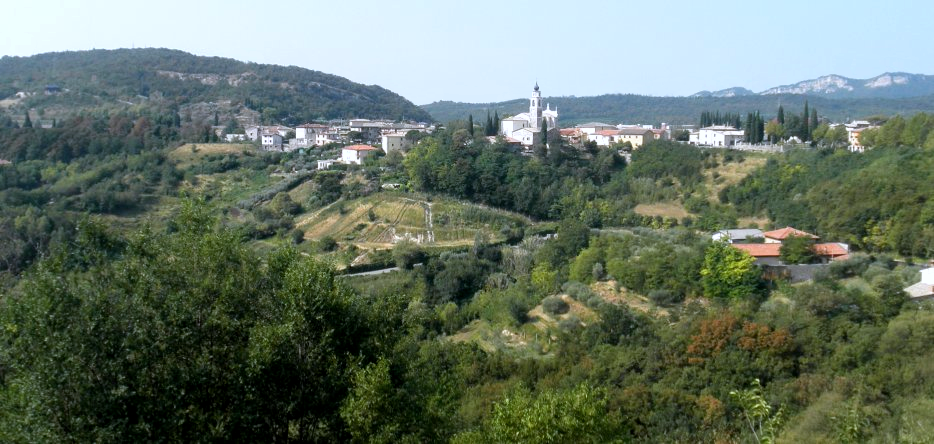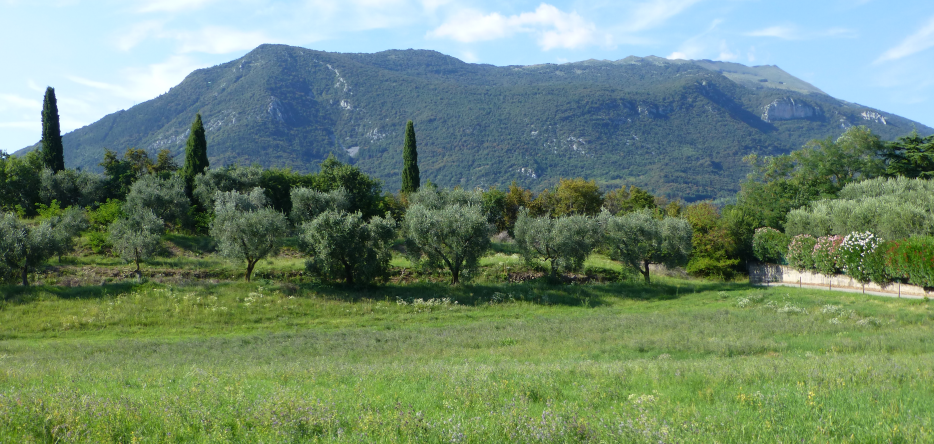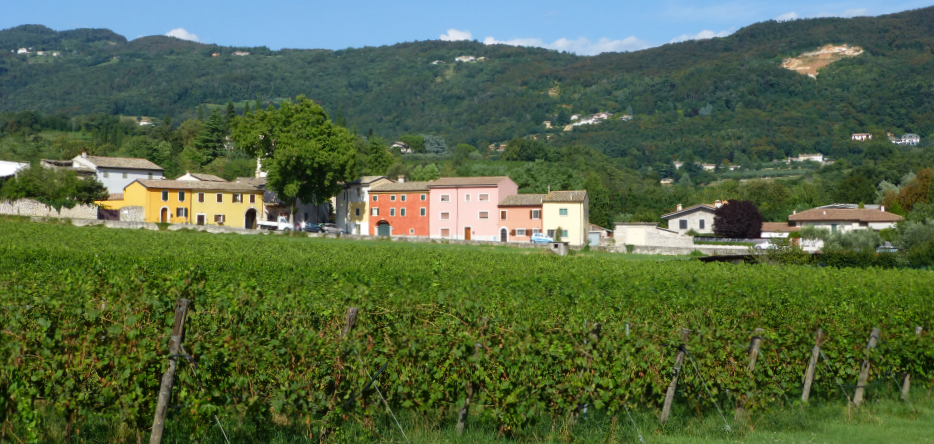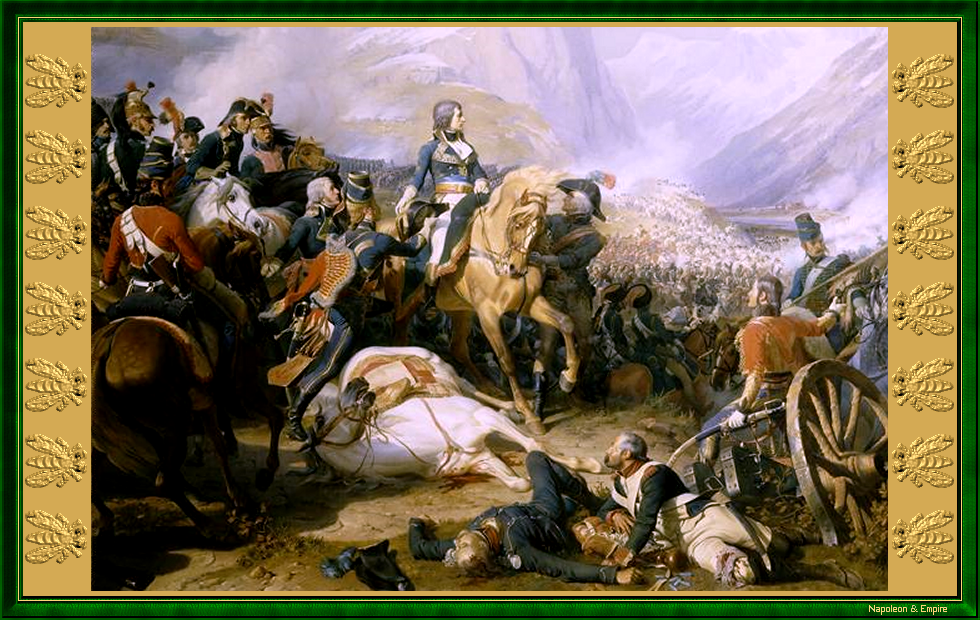Date and place
- January 14th and 15th, 1797 near Rivoli Veronese, Venetia (nowadays Province of Verona, Italy).
Involved forces
- French army (19,000 to 23,000 men) under General Napoleon Bonaparte.
- Austrian army (28,000 men) under Baron Josef Alvinczy von Borberek.
Casualties and losses
- French army: 2,200 men killed or wounded, 1,000 prisoners.
- Austrian army: 4,000 men killed or injured, 8 to 10,000 prisoners, 8 cannons, 11 flags.
Aerial panorama of Rivoli battlefield
The battle of Rivoli is known as the brightest French victory of the first Italian campaign. It closed the phase of the Austrian offensives in northern Italy and opened the way to Vienna [Wien] to the Republican troops of Napoleon Bonaparte.
Overall situation
Despite their defeat at Arcole in November 1796, the Austrians were still committed, at the beginning of the following year, to make all the necessary efforts to deliver the city of Mantua [Mantova] , besieged for seven months, and where General Dagobert Sigmund von Wurmser locked himself after the battle of Bassano .
The city , with a garrison of nearly 30,000 men, was indeed the key port of entry to northern Italy and only its resistance prevented the French army from continuing its offensive towards Austria, as the future would prove soon.
It was therefore under the impulse of an imperious necessity that Austria managed, in just two months, to set up a new army of 45,000 men, which it confided, as the previous one, to General Josef Alvinczy von Borberek.
He divided his forces into three unequal units. The first two, with a total of 17,000 soldiers, under Adam Bajalics von Bajaháza (Bayalitsch) and Giovanni Provera command, moved respectively from the Brenta to Verona and Legnago on the lower course of the Adige .

Their main mission was to draw Bonaparte's attention to the plain while the third unit, with 28,000 men under the direct command of Alvinczy, would conduct the main attack in Rivoli Veronese .
Once this position had been conquered, these three bodies converged on Mantua, whence Wurmser, gave the Austrians a clear numerical superiority.
Opposite, the French had about 42,000 men, including 7,000 received as reinforcement after Arcole. They were organized into five divisions:
- That of Barthélemy Catherine Joubert occupied the position of Rivoli , north of which it advanced about ten kilometers to La Corona [Madonna della Corona]
- André Masséna was defending Verona
- Charles Augereau was covering Legnago
- Jean-Mathieu Philibert Serurier was blocking Mantua
- General Gabriel Venance Rey was stationed in Desenzano with a reserve division, smaller than the other four.
Bonaparte himself stood at the center of the apparatus, ready to intervene as quickly as possible, if needed.
Preliminary operations
The Austrian offensive on Rivoli began January 12, 1797 by the attack on the French positions of La Corona. Joubert, strongly entrenched, resisted all day and then retreated the next day on Rivoli on hearing that an Austrian column was overflowing on his left. This retreat was executed in order and almost without losses, no significant combat being reported until the end of the day.
The Austrians, confident in their numerical superiority, were content to slowly make arrangements that were aiming not only to defeat the French but also to surround them and obtain their surrender.
On the 13th, at around ten o'clock in the evening, having received neither commands nor reinforcements and noting that the surrounding mountains were covered with enemy troops, Joubert decided, in order to avoid being crushed or encircled the following day, to back off again. He was starting to move when he received the news of the imminent arrival of the general-in-chief, accompanied by the bulk of the Masséna division. The order got also transmitted to him to stand ahead (so north) of Rivoli . He executed it immediately.
Bonaparte, in fact, in view of the fighting on the 12th and 13th in the plain, as well as the reports sent to him by Joubert, had convinced himself that the main effort of the Austrians would be focused on the position held by the latter.
He therefore took steps to contain the two enemy corps operating in the plain while he concentrated his troops to meet the third. He was going to bring with him nearly 12,000 reinforcements to Joubert, which would bring the final number of French troops to twenty thousand combatants on the battlefield.
Bonaparte arrived at Rivoli at about two a.m., largely preceding Massena's troops, and ordered Joubert to attack at dawn, without waiting for their arrival.
Field

The Rivoli site forms a semi-circular plateau surrounded by low heights but with rather steep slopes. To the north, they go down into the valley of Caprino at the bottom of which flows a stream, the Tasso . On this side, various accesses exist, either by the paths which, coming from Corona or Monte Baldo , give on Trambasore and San Marco , or by the two roads which follow the Adige .
That of the right bank is confined between the river on the one hand and the monte Magnone on the other, and climbs on the plateau in the direction of Osteria through Canale [Incanale] . The site of the San Marco Chapel [nowadays a fort built in the late nineteenth century], which dominates the road from the top of Monte Magnone, therefore commands the northern access to the plateau.
The path on the left bank goes beyond Rivoli Veronese before reaching the small fort of La Chiusa, which hermetically encloses the passage.
Such as they were in 1797, these approaches forbade bringing with it cavalry or artillery, however important, except for the Canale road, whose exits it was very difficult to force. On the south side, on the contrary, bringing supplies was not difficult, which favored the defender in this case.
The Austrian arrangements
Alvinczy divided his troops in six columns:
- The first one, with a force of 5,000 men was commanded by Colonel Franz Joseph of Lusignan , made a large movement turning to the right (the west), passing through Lumini and Pesina. It intended to show up on the side of Affi , southwest of Rivoli, not far from the road by which French reinforcements would be expected to arrive.
- The second column, of 4,700 men, under Anton Lipthay (or Liptay) of Kisfalud command, and the third of 4,000 under Samuel Köblös of Nagy-Varád command, would attack the northern edge of the plateau, respectively Trambasore and San Marco. A victory on this side could open the way to Canale to the Austrians.
- The 3,400 soldiers in the fourth column, entrusted to Joseph Ocskay von Ocskó, were assigned to support the two previous ones. So they had to turn around in the Adige valley, where they had already entered, to go back to Belluno Veronese and returned by Ferrara and La Corona.
- The fifth column, under Peter Vitus von Quasdanovich , continued to advance on the road to the right bank of the Adige in the hope of opening the way to Canale. It concentrated by necessity most of the cavalry and the artillery, to which the state of the roads forbade to follow the other columns.
- The sixth column, under Joseph Philipp Vukasovic (Wukassovich) command, took the road to the left bank of the Adige. This column was in charge of seizing the fort of La Chiusa, of throwing a bridge over the river and of startling, just as Lusignan but by the other wing, on the rear of the enemy.
The synchronization of all these maneuvers, in the middle of winter and in a mountain region, was a challenge that would not be kept.
14th of January
First fights
At four o'clock in the morning, Joubert mounted the offensive. Leaving the 39th demi-brigade around Osteria to watch the road to Canale, he went straight to the North. On the way, he easily regained San Marco, kept by only a limited number of troops, then entered the valley of Caprino , where it collided with the bulk of Austrians, formed of their second, third and fourth columns.
These 12,000 men fought for several hours against the 8,000 men of Joubert division and gradually took over. At 7 a.m. Liptay counter-attacked vigorously from the foot of Monte Baldo from which he was first repulsed.
The French left flank retreats in the greatest disorder on Trambasore.
At the same time, on the right side, General Honoré Vial had to return San Marco to the enemy after a fierce confrontation. Only the 14th half-brigade, in the center, around San Giovanni, continued to hold up. But the first units of Quasdanovich began to appear on the plateau, through the road to Canale. The situation was becoming tricky for the French.
Massena’s arrival
Massena’s arrival, around ten o'clock in the morning, changed the course of events. Bonaparte immediately went to the rescue of Joubert's left side with the 2,000 men of the 32nd demi-brigade, who formed the vanguard of the newcomers. This support helped balancing the situation. Liptay got once again pushed back to the foot of Monte Baldo.
The other two half-brigades brought by the future Duke of Rivoli (Masséna), the 18th and the 75th, moved: the first one towards Garda to watch the left flank of the battlefield, the second one as close to Rivoli as possible and was held in reserve.
Meanwhile, the other Austrian columns had progressed and began to appear on battlefield. Lusignan appeared in Affi. Two of Garda's recalled battalions slowed him down near Costermano without stopping him. Wukassovich, on the left bank of the Adige, settled within sight of Somano, from where he bombed the 39th demi-brigade which guarded the way to Canale while Quasdanovitch climbed the slopes.
After the evacuation of San Marco by Vial, the 39th demi-brigade was forced to abandon the Osteria, leaving the head of Quasdanovich’s column progress on the plateau. Masséna having difficulty in containing Liptay in Trambasore, the situation for the French at this moment of the battle could seem, once again, worrying.
Further analysis revealed a very different reality:
- The Austrians of Liptay, Köblös and Ocskay were exhausted by the battles fought since dawn;
- Quasdanovich only had a very small amount of troop on the plateau while the rest of his men were engaged in the difficult climb of the slope;
- Lusignan was still very far from being able to intervene where the fate of the battle was played out. He was even in danger of being taken by the imminent arrival of French reserve troops, 3,000 men that General Rey brought from Castelnovo del Garda , towards the south.
Failure of Austrian’s left wing
More or less aware of these different parameters, Bonaparte kept his composure in the difficult situation that his situation seemed to be in and soon rebalanced it.
The 75th half-brigade, too far from Joubert's right side to be able to rescue it, got sent to join the two battalions of the 18th who had just started harassing Lusignan. Their joint mission was to occupy the heights of Tiffaro [Fiffaro] [45.57011, 10.78982], on the western edge of the plateau, to thwart the progress of the Austrian column.
At the same time, Bonaparte sent the 600 men of Joubert's reserve cavalry under Charles Victor Emmanuel Leclerc's orders, and the 39th demi-brigade, in close formation, on Quasdanovich's head of the column. It got quickly repulsed and its retrograde march confused the accumulation of men, horses and equipment that cluttered the road to Canale.
The French followed their attack with intense cannonade delivered by the 15-piece battery installed in Zoane [Zuane]. The unexpected explosion of two caissons of Austrian artillery, in the midst of the crowd of fugitives, rounded off the disorganization of the body of Quasdanovitch that the French rifled copiously from the heights.
The Austrian defeat in this sector turned out to be total. Wukassovich himself, on the left bank of the Adige, turned around.
Defeat of the Austrian center
Once this victory was set, the right wing of Joubert and his cavalry were sent to support the center where Vial had to deal with Ocskay and Köblös. But, when they arrived to Mutole [Matole], and because of the way they were progressing, they ended up offering their right flank to the blows of Masséna, who held the heights of Trambasore [45.59727, 10.80534] after having rejected Liptay.

The simultaneous appearance on their left of new masses of French infantry and 200 cavalry led by the squadron leader Antoine Charles Louis de Lasalle caused a panic movement in the ranks of the two Austrian columns, which could not oppose their enemies or cavalry or artillery. They let go and retreated behind the Tasso to the first slopes of Monte Baldo, leaving a thousand of theirs in the hands of the French.
Liptay, at the head of the last column of the center still operational, no longer considered himself in a position to continue the fight and withdrew beyond Caprino. It was around noon.
Rout of the Austrian right wing
The left wing and center opponents defeated, Bonaparte turned against Lusignan who had finally entered the theater of operations by taking the Monte Pipolo . Ignoring what happened a little earlier north of the battlefield, the Austrian column thus opened south of Rivoli, too late to exert any influence on the outcome of the fight but still in time to be crushed as well.
At 3 p.m., it got attacked by the 18th and 75th demi-brigades gathered, whose intervention turned out to be decisive against a troop devoid of guns.
To make things worse, Lusignan saw General Rey on his rear, arriving from Orza with his division. Lusignan first tried to resist, with the only result being the aggravation of its losses. He then fled towards Garda but the remaining 1,200 soldiers collided with some isolated French companies.
Believing themselves surrounded, the Austrians then put down most of the weapons and surrendered. Lusignan managed to escape by Lake Garda with some companions. That's all that remained of the 5,000 men entrusted to his command by Alvinczy.
Bonaparte departure
At five o'clock, only the remains of Quasdanovich's column were still able to fight, but they withdrew into the Adige valley , up to Rivalta, ten kilometers to the north. Bonaparte was about to attack him when he learnt that Provera had passed the Adige to Anghiari and was walking on Mantua.
Joubert received, without further delay, the task of completing the victory. The body of Rey got left to him as reinforcement while the general-in-chief left for the plain with the Masséna division.
In the evening, Bonaparte gathered his generals at the Ca' del Ri , in Affi [45.55278, 10.77757].
15th of January
The next day, Alvinczy had already retreated far enough to be able to hope that the distance gained during the night would allow him to get off La Corona towards Brentino without danger. Although he still had to lead his army through paths cut on the slopes of Monte Magnone. He then had the best chance of escaping his pursuers.
However, uncertain of the fate of his right wing and eager to facilitate the withdrawal while retaining some French troops in the mountains while Provera operated in plain, Alvinczy attempted an offensive return on the morning of the 15th.
On the French side, the measures taken by Joubert actually aimed to disturb or even cut the enemy line of retreat. His right wing, under Vial, is on the Monte Magnone; his left wing, with Veaux, and his extreme left, reunited with Joachim Murat who landed at Torre [Torri del Benaco] and marched on Ferrara, climbed the slopes of Monte Baldo.
While these columns attempted to seize the retreat routes of the Austrians by counteracting them, the French center, under Louis Baraguey d'Hilliers , collided head-on with the enemy who decided to turn around. The shock took place in San Martino :

After just one hour of fighting, Alvinczy, drawing the consequences of the flagrant lack of pugnacity shown by his troops, ordered the retreat. This one quickly turned to a total fiasco. The fear of being barred by the French wings pushed the Austrian soldiers to panic. Their march was transformed into a disheveled flight, slowed down by the topography, a narrow and abrupt path.
For many of them, the nightmare became reality and more than 5,000 men were captured by the French detachments who preceded them to La Corona.
This last episode represented the outcome of a battle in which the Austrian losses amounted to 14,000 soldiers out of the 28,000 engaged, of whom nearly 10,000 laid down their weapons. The French, for their part, had in all just over 3,000 killed, wounded and prisoners.
Consequences of the battle
The victory of Rivoli had an immense impact in Europe. Followed the next day by the La Favorita one, it paved the way for the fall of Mantua (February 2). The road to Vienna opened ahead of the French army, which would be taking it two months later. In the meantime, even in Italy, Pope Pius VI, now deprived of allies, soon had no choice but to sign the Treaty of Tolentino. The pontiff ratified the annexation of Avignon and Comtat-Venaissin by France and ceded to it the legations of Bologna, Ferrara and Romagna.
Map of the battle of Rivoli

Picture - "General Napoleon Bonaparte at the Battle of Rivoli". Painted 1844 by Henri-Felix-Emmanuel Philippoteaux.

The Masséna division arrived on the battlefield and returned the situation after having traveled more than one hundred and forty kilometers in two days, including the last twelve hours in forced march. Napoleon Bonaparte wrote in this connection, in a letter to the Directory, that "these soldiers surpassed the speed of Caesar's legions."
At the end of the year 1796 and in January 1797, the headquarters of Napoleon Bonaparte was at the Forti Palace in Verona.
A monument commemorating the victory of the French was erected in 1807 near the village of Rivoli Veronese [45.58100, 10.82111]. Destroyed by the Austrians in 1814, it was rebuilt in 1917-18 by "les Poilus" of the French Army of Italy, in honor of their elders of 1797. Display the Map of the First campaign in Italy (1796-97)
Display the Map of the First campaign in Italy (1796-97)
Photos Credits
Photos by Lionel A. Bouchon.Photos by Marie-Albe Grau.
Photos by Floriane Grau.
Photos by Michèle Grau-Ghelardi.
Photos by Didier Grau.
Photos made by people outside the Napoleon & Empire association.